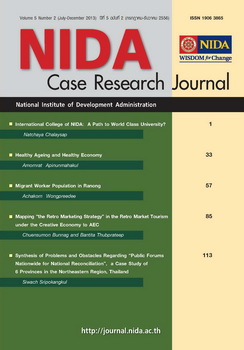Migrant Worker Population in Ranong
Keywords:
Migrant Worker in Thailand, Ranong, Burmese Worker in ThailandAbstract
By mid-2012, the illegal migrant worker issue in Thailand had become a matter of grave and urgent concern to several segments of the Thai polity and society. Sharing borders with several cheap-labor countries where economic opportunities were limited and political oppression prevalent, Thailand had become a safe haven for thousands of poor nationals of adjacent countries desperate to escape social, economic, and political hardships in their own countries for the opportunity of a better life. In the process, they had largely displaced Thai workers from the Northeast of the country who, in earlier decades, had similarly migrated to the factories and industrial estates in Bangkok and Southern Thailand in search of improved economic prospects and relief from the relative impoverishment of their native region. As a result, many Northeasterners had in recent decades re-directed their quest for high-paying jobs to overseas destinations such as Taiwan and the Middle East, leaving many of the lower-paying jobs to migrant workers from Thailand’s poorer neighbors.While migrant worker labor had grown substantially in nearly all regions of the country (but most especially in those areas that shared a nearby border with a neighboring country), few regions had experienced increases as dramatic as those of Ranong Province on Thailand’s southwest coast. In addition to having a 169 kilometer land border and a nearly 90 kilometer maritime border with Myanmar, Ranong’s maritime area included 62 islands and islets – both of which made it exceedingly diff icult for Thai authorities to control the inf low of illegal migrants from Myanmar.
ecome a multi-dimensional public policy issue that was challenging the problem-solving skills of managers in public, private, and civil society organizations alike. Almost all aspects of public policy formulation and implementation were being affected by migrant workers from the neighboring countries of Myanmar, Laos, and Cambodia. Education and healthcare services, human traff icking, and crime were just three of areas in which there had arisen social problems stemming from the inf lux of illegal migrants. Administratively, the Thai government was also impacted, as it had to allocate more f inancial and personnel resources to strengthen border security, to prevent future in-migration, and to support public agencies that directly dealt with illegal migrant workers.
Yet, despite the critical public policy issues that stemmed from the migrant worker phenomenon, resolution of the problem had, to date, proven elusive. With several groups of stakeholders in the matter, the government had found it diff icult to devise and adhere to a comprehensive plan for ameliorating the problem because of the different perspectives, different priorities and different solution preferences of the multiple interested and affected parties. The lack of consensus concerning what actions to take to address the problem, along with a lack of policy continuity due to changes of government, had stymied attempts to bring the problem under control and perhaps even launch a sustained effort to repatriate the illegal segment of the migrant work force to their home countries.
By mid-July 2012, however, nearly all stakeholders were increasingly of the view that opportunities to address the problem, once and for all, were slowly slipping away. There was widespread agreement that left unaddressed for much longer, the economic, social, and political repercussions of the uncontrolled ingress of migrant workers could become even more intractable and impervious to ameliorative efforts. In the words of a former Ranong provincial governor before his departure for a post in another province, “All concerned stakeholders needed to conduct further research on the problem to f ind a solution.”
Downloads
How to Cite
Wongpreedee, A. (2014). Migrant Worker Population in Ranong. NIDA Case Research Journal, 5(2), 57–83. retrieved from https://so04.tci-thaijo.org/index.php/NCRJ/article/view/27663
Issue
Section
Case Study





